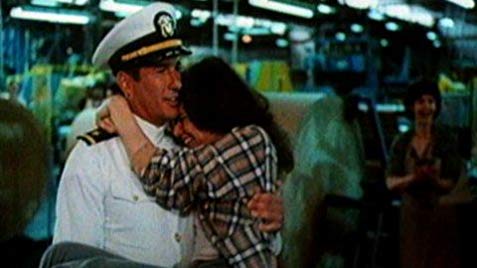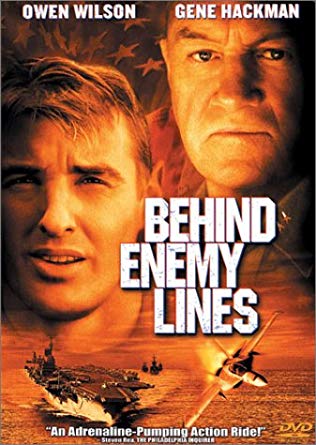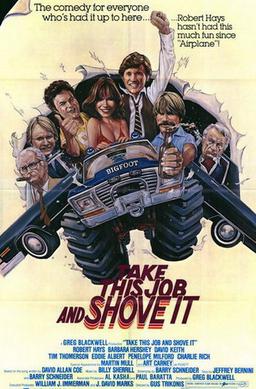Almost everyone knows that one scene from the 1982 film, An Officer and a Gentleman. You can probably guess which scene it is that I’m talking about. It’s been parodied and imitated in so many other shows and movies that it’s one of those pop cultural moments that everyone has “seen” even they haven’t actually watched it. It’s the scene where….
I AIN’T GOT NOWHERE ELSE TO GO!
What?
I AIN’T GOT NOWHERE ELSE TO GO!
I know, Mayo, I’m getting to that! Let me tell everyone about the iconic factory scene first, okay?
I AIN’T GOT NOWHERE ELSE TO GO!
Uhmmm …. right. Where was I? Oh yeah, it’s the scene where Debra Winger is working in a factory and a youngish Richard Gere suddenly shows up and he’s wearing a white uniform and he picks her up and carries her out of the factory while all of her coworkers cheer. Meanwhile, that Up Where We Belong song starts to play on the soundtrack. Even though, up until recently, I had never actually sat down and watched An Officer and a Gentleman, I certainly knew that scene.
Last Friday, I noticed that I had An Officer and a Gentleman saved on the DVR and I thought to myself, “Well, I might as well go ahead and watch it and find out what else happens in the movie.” Add to that, I only had three hours of recording space left on the DVR so I figured I could watch the movie and then delete it and free up some space….
I AIN’T GOT NOWHERE ELSE TO GO!
Goddammit, Mayo, be quiet! I’m getting to it!
Anyway, I watched the film and I discovered that it’s actually about a lot more than just Richard Gere getting Debra Winger fired from her job at the factory. It’s also about how Zack Mayo (the character played by Richard Gere) hopes to make something of himself by graduating from Aviation Officer Candidate School so that he can become not only a Navy pilot but also an officer and a gentleman. His father (Robert Loggia) is an alcoholic, his mother committed suicide when Mayo was a child and Mayo …. well, I’ll let him tell you himself.
I AIN’T GOT NOWHERE ELSE TO GO!
That’s right. Mayo has not got anywhere else to go.
I AIN’T GOT NOWHERE ELSE TO GO!
Ain’t is not a word, Mayo.
As you may have already guessed, we know that Mayo doesn’t have anywhere else to go because there’s a scene where he continually yells, “I ain’t got nowhere else to go!” over and over again. He yells it after being forced to do a thousand push-ups and sit-ups by his drill sergeant, Foley (Louis Gossett, Jr.) Foley thinks that Mayo doesn’t have the right attitude to be either an officer or a gentleman. Mayo is determined to prove him wrong.
I AIN’T GOT–
Oh give it a rest, Mayo!
Debra Winger plays Paula. Paula is a townie. She lives in a dilapidated house with her parents. Her friend, Lynette (Lisa Blount), dreams of marrying a Naval officer and getting to travel the world. Lynette gets involved with Mayo’s friend, Sid Worley (David Keith). Foley warns both Sid and Mayo to stay away from the townie girls because they’re not to be trusted. That turns out to be true in Lynette’s case but Paula’s love provides Mayo with the strength that he needs to believe in something more than just himself.
I AIN’T–
Yes, you do have some place to go, Mayo! That’s the point of the whole goddamn movie!
Anyway, watching An Officer and a Gentleman, I was kind of surprised to discover that it’s actually two movies in one. It’s a traditional army training film, one in which Richard Gere is whipped into shape by a tough drill sergeant. It’s also a film about life in an economically depressed small town, where the only hope of escape comes from marrying the right aviation officer candidate. As a military film it’s predictable if occasionally effective. As a film about small town life, it’s surprisingly poignant. An Officer And A Gentleman doesn’t pull any punches when it comes to depicting just how little life in the town has to offer to people like Paula and Lynette. They have spent their entire lives being told they can either work in a factory for minimum wage and get drunk on the weekend or they can land a man who will hopefully take them away from all that and give them something more to look forward to than cirrhosis of the liver. Lynette has accepted that as being her only option. While Paula dreams of escape, she dreams of escaping on her terms. She may fall in love with Mayo but she’s not going to pretend to be someone that she’s not just to keep him around.
Though he’s evolved into a good character actor, Richard Gere was remarkably blank-faced when he was younger and his performance as Mayo alternates between being bland and shrill. However, Debra Winger brings a welcome edge to her role. She plays Paula as someone who knows she’s stuck in a dead end existence. She’s not happy about it but, at the same time, she’s not going to surrender her principles in order to escape. She holds onto her ideals, even though she appears to be stuck in a crappy situation and that’s something that Mayo learns from her. In the end, Paula saves Mayo just as surely as the Navy does. And, just as Paula saves Mayo, Winger saves the movie.
I AIN’T GOT NOWHERE ELSE TO GO!
Oh, shut the Hell up, Mayo. Go pick up Paula and carry her off to a better life….



 Originally from a small town in Iowa, Frank Macklin (Robert Hays) is a hotshot young executive with The Ellison Group. When Frank is assigned to manage and revitalize a failing brewery in his hometown, it is a chance for Frank to rediscover his roots. His childhood friends (played by actors like David Keith, Tim Thomerson, and Art Carney) may no longer trust him now that Frank wears a tie but it only takes a few monster truck rallies and a football game in a bar for Frank to show that he is still one of them. However, Frank discovers that the only reason that he was sent to make the brewery profitable was so that his bosses could sell it to a buffoonish millionaire who doesn’t know the first thing about how to run a business. Will Frank stand by while his bosses screw over the hardworking men and women of the heartland? Or will he say, “You can take this job and shove it?”
Originally from a small town in Iowa, Frank Macklin (Robert Hays) is a hotshot young executive with The Ellison Group. When Frank is assigned to manage and revitalize a failing brewery in his hometown, it is a chance for Frank to rediscover his roots. His childhood friends (played by actors like David Keith, Tim Thomerson, and Art Carney) may no longer trust him now that Frank wears a tie but it only takes a few monster truck rallies and a football game in a bar for Frank to show that he is still one of them. However, Frank discovers that the only reason that he was sent to make the brewery profitable was so that his bosses could sell it to a buffoonish millionaire who doesn’t know the first thing about how to run a business. Will Frank stand by while his bosses screw over the hardworking men and women of the heartland? Or will he say, “You can take this job and shove it?”